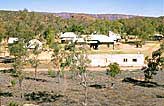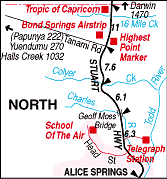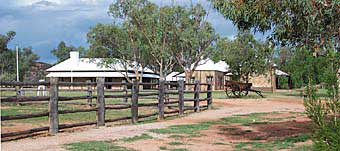
Old building in the Telegraph Station reserve.

The layout of the Old Telegraph Station.

Stationmasters were:
1875-1879 Johannes Mueller
1879-1887 Ernest Flint
1887-1892 Joseph Skinner
1892-1899 F.J.Gillen
1899-1908 Thomas Bradshaw
1908-1916 John McKay
1916-1924 Frederick Price
1924-1932 Ernest Allchurch
In October 1870 the South Australian government allocated $250,000 for the construction of an Overland Telegraph Line from Port Augusta in South Australia, to Palmerston (now Darwin), along a route closely following that of explorer John McDouall Stuart, who successfully traversed the continent at his third attempt on July 24th 1862. Construction of the 3,000 kilometre line was in three sections. Private tenders were called for two sections of 800 km. each. Messrs. R.R. Knuckey, G.R. McMinn, H. Harvey, A.T. Woods and W. Mills, divided up the remaining 1400 km., to be built through the little known central area. A Scotsman, John Ross, assisted by Alfred Giles, was appointed to find a shorter route through this central mountainous region, however, it was surveyor Mills who discovered Heavitree Gap, at the southern entrance to Alice Springs, and who found and named Alice Springs, the site for the telegraph station.
Construction of the telegraph line began in 1871 and the first morse signals were sent along the completed southern section of the line in December of that year. The north and central sections of the line were eventually joined on August 22nd, 1872 at Frew Ponds, near Dunmarra, but problems with the undersea cable linking Palmerston with Java were not resolved until October. The final cost of the line was nearer twice the original estimate, but the prestige for South Australia was immense.
The Telegraph Station became the centre of activity in the area and gradually outbuildings were added. These included policemen's quarters, harness and buggy sheds, a Stationmasters residence, a battery room, blacksmith's shop and a kitchen-mess room. Like the original Telegraph Station these were all built with local stone and lime mortar. They had thatched rooves which were later replaced with galvanised iron.
The Telegraph Station operated 24 hours a day and was one of 11 along the 3,000 km line, It was basically self-sufficient, relying on provisions from the south only once a year. Sheep, goats, cattle and their own vegetable garden ensured adequate food and the blacksmith made much of their equipment. The first Stationmaster was Johannes Mueller (1872-1879), other staff consisted of 4 telegraphist-linesmen, a teacher-governess, a cook, and a stockman-blacksmith. The station operated until 1932 when more modern facilities were established in the new township of Stuart, at the corner of Railway Terrace and Parsons Street. This facility has also been replaced by the modern Post Office in Hartley Street and the Telecommunications Centre at the corner of Bath Street and Parsons Street.
Since its closure the original station has been, an education centre for part aboriginal children (1932-42); a wartime army base (1942-1945); and an aboriginal reserve (1945-1963) In 1963 the aboriginal people moved to Amoonguna, an aboriginal settlement south-east of town which still exists today, and the station was gazetted as the Alice Springs Telegraph Station National Park.
The then Northern Territory Reserves Board (later the Conservation Commission) began a programme of reconstruction of the old buildings from photographs of the settlement at the turn of the century. This resulted in a restoration of the buildings and area as it looked between 1895 and 1905. The Telegraph Station partially reopened to the public for business but now operates only on significant historic occasions when letters can be sent under the stations own franking mark to anywhere in the world.
The site was originally chosen for its proximity to the permanent spring and its picturesque setting. Consequently it is a popular picnic spot for locals and tourists. Grassy banks shaded by lovely river gums make an ideal setting for a picnic or barbecue, and facilities include picnic tables and toilets. Barbecue packs and picnic items can be obtained from the kiosk.
A small cemetery lies some 900 metres west of the station along a dirt walking track and contains the remains of early employees, Stationmaster Ernest Flint, who died of rheumatic fever 17th July, 1887; 'R.I.P. The Surveyor'. The short walk past the rangers house is picturesque and rewarding.
The Telegraph Station is the original Alice Springs, and as such, an important part of a Central Australian tour. Opening times of the park are; 8am- 9pm daily and the buildings are open from 8am to 5 pm daily except Christmas Day. Guided Tours of the Historical Precinct operate throughout the year. Phone (08) 8952 3993 to confirm tour times. There is no camping in the reserve.
There is an admission charge to the historic buildings which includes a brochure and tour. It was $9 adult $5 child. (0-16)

The Telegraph buildings at the reserve.

